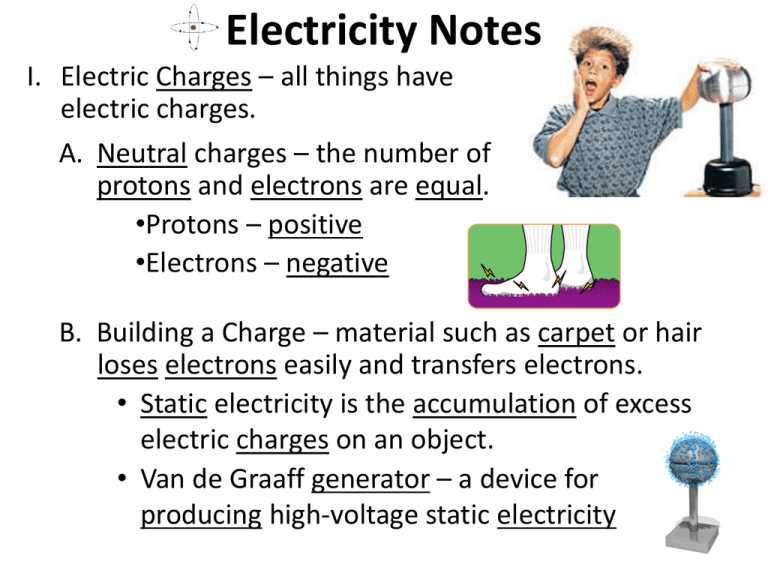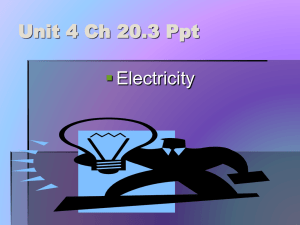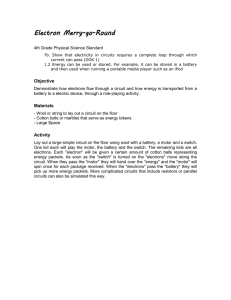Electricity
advertisement

Electricity Notes I. Electric Charges – all things have electric charges. A. Neutral charges – the number of protons and electrons are equal. •Protons – positive •Electrons – negative B. Building a Charge – material such as carpet or hair loses electrons easily and transfers electrons. • Static electricity is the accumulation of excess electric charges on an object. • Van de Graaff generator – a device for producing high-voltage static electricity C. Conservation of Charge Law of Conservation – applies to charges in the fact that charges cannot be created or destroyed, but only transferred. • Opposites attract – opposite charges attract and like charges repel. • Electric Fields – an electric field surrounds every charge. II. Conductors and Insulators A. Conductors allow electrons to move easily. • Metals are excellent conductors. • Semiconductor – material such as silicon and germanium that are neither a good conductor nor insulator. Only can be used as a conductor if impurities are added. B. Insulator – material that does NOT allow electrons to move through easily. III. Storms and Electricity A. Lightning is a static discharge. Static discharge is a transfer of electric charges through the air between two objects because of a buildup of charges. B. Thunder – caused by the heat energy of lightning. What Gives Lightning it's Zap? • Lightning happens when the negative charges (electrons) in the bottom of the cloud are attracted to the positive charges (protons) in the ground. What Gives Lightning it's Zap? • The accumulation of electric charges has to be great enough to overcome the insulating properties of air. When this happens, a stream of negative charges pours down towards a high point where positive charges have clustered due to the pull of the thunderhead. What Gives Lightning it's Zap? • The connection is made and the protons rush up to meet the electrons. It is at that point that we see lightning and hear thunder. A bolt of lightning heats the air along its path causing it to expand rapidly. Thunder is the sound caused by rapidly expanding air. D. Grounding – connecting an object to Earth with a conductor. • The earth is a large neutral object such that if a conductor is connected to the Earth, it will ground out or become neutral. • Lightning rods are used in homes to ground out. IV. Electrical Pressure A. A voltage difference is the push that causes charges to move and is measured in volts (V). B. Charges flow from high voltage areas to low voltage areas. + – V. Circuits A. Closed Circuits – a closed, conducting path. • The flow of charges through a wire is the electric current. • The electric current is measured in amps. • Current is almost always the flow of electrons. B. Electric Circuits • To use electrical energy, a complete circuit must be made. • Circuits typically include a voltage source, a conductor such as wire, and one or more devices that use the electrical energy to do work. C. Series Circuits • In a series circuit, the current only has one loop to flow through. • Series circuits are used in flashlights and holiday lights. D. Parallel Circuits • Parallel circuits contain two or more branches for current to move through. • Most houses are wired with parallel circuits. E. Household Circuits • Most household wall sockets are 120 V while the dryer and stove requires a 220 or 240 V. • All household circuits contain either a fuse or a circuit breaker. VI. Circuit Overload Protection A. Fuses • An electrical fuse contains a small piece of metal that melts if the current becomes too high. • Too many appliances in use at the same time is the most likely cause for the overheating of the circuit. B. Circuit breaker – a circuit breaker is a guard against overheating. • A circuit breaker contains a piece of metal that bends when it gets too hot. • The bending causes a switch to flip and open the circuit. VII. Batteries – a battery is a device used to maintain a voltage difference. A. Dry-Cell Batteries • A dry cell battery is the typical individual batteries used. Ex (AA,D) • There is a positive and negative terminal on each battery, causing a voltage difference. The voltage difference causes a circuit to flow. B. Wet Cell Batteries • A wet cell battery contains two connected plates made of different metals in a conducting solution. • An example of a wet celled battery is a battery used in a car. • As a car is driven, the alternator recharges the battery by sending current through the battery in the opposite direction to reverse the chemical reaction. VIII. Resistance – the tendency for a material to oppose the flow of electrons, changing electrical energy into thermal energy and light. • Resistance is measured in Ohms (Ω). • Thinner wires have a greater resistance to electron flow, as opposed to thicker less resistant wires. • Longer wires have more resistance than shorter wires. IX. Ohm’s Law • Current (I) is measured in Amperes (amps). • Voltage (V) difference is measured in Volts. • Resistance (R) is measured in Ohms. current = voltage difference/resistance X. Electrical Power – the rate at which electrical energy is converted to another form of energy. • Power is measured in Watts. • Current is measured in amps. • Voltage is measured in volts. Power = current X voltage XI. Electrical Energy – the amount of electrical energy you use depends on two things: 1. Power required 2. How long it is used Calculating Electrical Energy • Energy is measured in kilowatt-hours (kWh). • Power is measured in kilowatts (kW). • Time is measured in hours (h). Energy = Power X time Draw a matching circuit using symbols.







